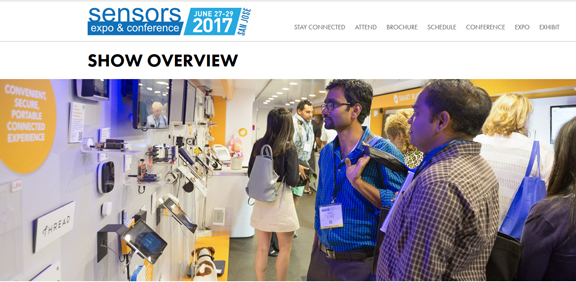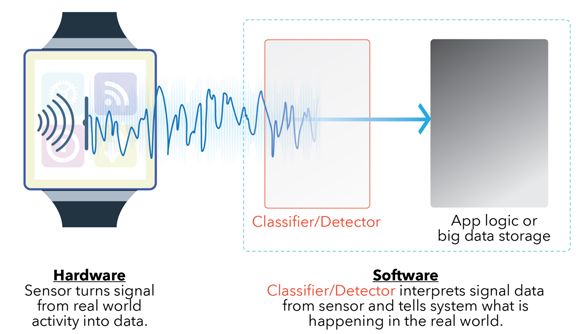
At Sensors Expo 2017, keynotes, featured tracks, and hallway conversation highlight the role of sensors in IoT and AR-VR.
Latest News
July 7, 2017
 At Sensors Expo 2017, keynotes, featured tracks, and hallway conversation highlight the role of sensors in IoT and AR-VR.
At Sensors Expo 2017, keynotes, featured tracks, and hallway conversation highlight the role of sensors in IoT and AR-VR.
Mark Benson, CTO of Exosite, thinks many current IoT projects are rather like assembling puzzles: Lots of different pieces, but very little direction.
Benson's firm offers its expertise, services, and cloud-based IoT platform Murano to manufacturers. Last month, at the Sensors Expo 2017 (San Jose, California, June 27-29), Benson shared his insights as a keynote speaker.
“I'm a father. I have three kids at home. We do puzzles pretty often ... Sometimes puzzle fever takes over, so we start opening multiple puzzles at the same time. Some pieces get intermixed. As a more advanced puzzle builder, I need to help my kids understand that we need to be working on the same puzzle, or we won't get satisfying results,” said Benson.
Global consultancy McKinsey & Company offers some numbers that reveal the size of the irresistible IoT pie. In 2013, the total number of connected objects was estimated to be 7-10 billion. That number is expected to grow annually at 15-20%, reaching 26-30 billion by 2020. McKinsey & Co.'s numbers scale back the 50 billion connected devices by 2020 predicted by Ericsson's President and CEO Hans Vestberg in 2010 at a shareholder meeting.
At the heart of these connected devices are sensors, actuators, SoCs (systems on chips), small enough to fit inside watches and smartphones but strong enough to power them for hours or days. These little things transform passive accessories and household appliances into data-collecting, data-transmitting, self-diagnosing IoT products.
“Because many applications would require devices that are self-sustaining and rely on energy harvesting or long-life batteries, semiconductor companies must address the need for optimal power consumption and outstanding power management in their products. Connectivity load will be another critical concern, since hundreds or even thousands of devices may need to be connected at the same time,” McKinsey & Co. pointed out.
 “IoT projects are like puzzles—lots of different pieces, very little direction,” said Mark Benson, CEO, Exosite, during his keynote at the Sensors Expo 2017 (photo courtesy of Exosite).
“IoT projects are like puzzles—lots of different pieces, very little direction,” said Mark Benson, CEO, Exosite, during his keynote at the Sensors Expo 2017 (photo courtesy of Exosite).
AR will be Bigger Than VR
IoT commerce is also inseparably linked to other emerging markets, such as AR-VR (augmented reality-virtual reality) and AI (artificial intelligence). Greenlight Insights, a market analyst, expects “VR global revenue to reach $7.2B in 2017, hiking at a steep rate to $75B by the end of 2021. Specifically, global headset adoption is expected to increase to 58% of the $75B revenue in 2021.industry's global revenue would tally up to $7.2B in 2017.”
Speaking at Sensors Expo in a session titled “A Market Forecast on Sensors in AR, VR, and AI,” Greenlight Insights analyst Alexis Macklin said, “We believe AR is going to be bigger than VR. It's going to be deployed in everyday usages, from a consumer driving a car to people on the factory floor.”
Many of the current AR-VR implementations let users use joysticks and trackers to interact with virtual objects or navigate scenes. The more sophisticated use cases would involve haptic technologies, especially in operations where the shape, texture, and response of the real tool is critical.
“Haptics [technologies that simulate touch-related sensations] will be important to AR,” said Macklin. “For example, in enterprise use cases, someone who usually works with clay to model a car might use it to better manipulate the digital model.”
Acquisitions and Expansions into the Sensor Realm
Among the exhibitors on the expo floor is Mentor Graphics, an electronics design software provider. In 2015, Mentor Graphics acquired Tanner EDA, a firm that specializes in software for the design, layout, and verification of analog/mixed-signal (AMS) and MEMS integrated circuits. Mentor Graphics itself was recently acquired by manufacturing solutions provider Siemens PLM Software.
Such transactions point to the industry leaders' desire to provide a suite of tools that comprehensively address concept designs involving IoT components. The design and deployment of sensors and electronics components was a gap that neither CAD nor PLM could adequately tackle.
In its whitepaper titled “Addressing the Challenges of IoT Design,” Jeff Miller, Mentor Graphics' product marketing manager, observed, “IoT designs mesh together several design domains in order to successfully develop a product that interfaces real-world activity to the internet. Individually, these design domains are challenging for today's engineers. Bringing them all together to create an IoT product can place extreme pressure on design teams.”
 Sensors Expo exhibitor Reality AI offers AI as a service to analyze signal data (image courtesy of Reality AI, from a company-published whitepaper).
Sensors Expo exhibitor Reality AI offers AI as a service to analyze signal data (image courtesy of Reality AI, from a company-published whitepaper).
AI to Make Sense of Sensor Streams
Also present on the expo floor are a number of AI solutions and service providers. With many sensors transmitting large volumes of real-time data, AI takes on a more prominent role in analyzing, organizing, and classifying the data streams for signs of anomaly, pending failures, or manual intervention. Reality AI, one of the exhibitors, bills itself as “software that makes sense of the physical world.” The company describes its offering as AI as a Service—that is, AI processing delivered in the SaaS (software as a service) model.
“Signals data include sound, images, accelerometry, vibrations, AC power, RF and inputs from other sensors covering a wide range of phenomena,” writes Reality AI in its whitepaper titled “AI as a Service for Signal Processing” (June 2016). “At the heart of the matter is feature discovery. For machine learning algorithms to work, they must be fed data containing measurements of salient features, and which features to use remains a difficult engineering problem ... [Our] techniques operate unsupervised or semisupervised to dynamically discover an optimal feature set for describing similarities between signals of the same class and differences between signals of different classes.”
IoT devices typically work in conjunction with online services and apps to enhance the consumer's experience (for example, a health-monitoring wristwatch with an accompanying mobile app). Furthermore, the product itself may need to rely on sensor input to make autonomous or semiautonomous decisions (for example, a smart vehicle using cameras, radars, and vibration sensors to detect wet roads, pot holes, and icy conditions). Therefore, analyzing the sensor data in real time and giving the user helpful prompts is part of the overall design of the product.
Previously, sensors and electronic components were commodity objects, bearing little effects on the overall design. In IoT products, the way these embedded items work—how they receive and transmit data, how they monitor the health of the product, and how they drive the operations in the associated mobile apps—is directly linked to the consumer's experience. They may be small, but without them, the puzzle cannot be completed.
Subscribe to our FREE magazine, FREE email newsletters or both!
Latest News
About the Author
Kenneth Wong is Digital Engineering’s resident blogger and senior editor. Email him at [email protected] or share your thoughts on this article at digitaleng.news/facebook.
Follow DE





